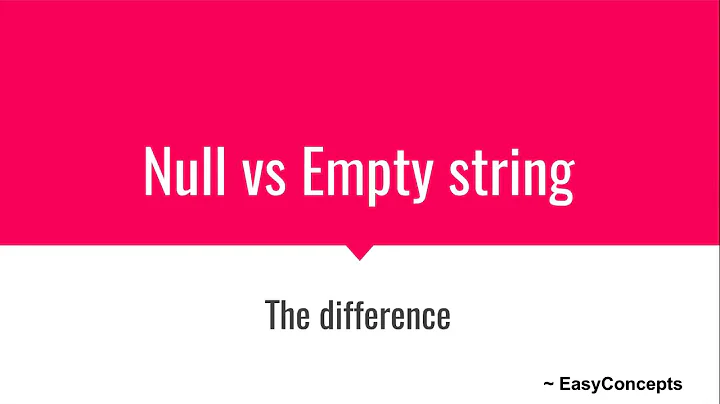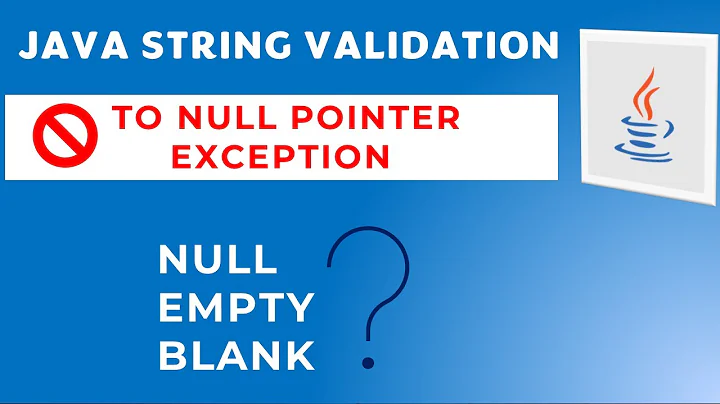What is the difference between null and empty?
Solution 1
A variable is NULL if it has no value, and points to nowhere in memory.
empty() is more a literal meaning of empty, e.g. the string "" is empty, but is not NULL.
The following things are considered to be empty:
- "" (an empty string)
- 0 (0 as an integer)
- 0.0 (0 as a float)
- "0" (0 as a string)
- NULL
- FALSE
- array() (an empty array)
- var $var; (a variable declared, but without a value in a class)
Example
$a is NULL.
$a = '' is empty, but not NULL.
Update
If
$a=''is empty but notNULL, when do I use theempty()function and when do I use theisset()function.
isset() will return FALSE is the variable is pointing to NULL.
Use empty() when you understand what is empty (look at the list above).
Also when you say it points nowhere in memory, what does that mean exactly?
It means that $str = '' will be in memory as a string with length of 0.
If it were $str = NULL, it would not occupy any memory.
Solution 2
Null is a placeholder that generally means "no data about this is available".
The use of null for this is just a convention, but a rather widespread one, to the point where some programming languages support the convention directly. The reason this convention exists has IMHO historically to do with "pointers"; many times a procedure will be defined to return a pointer to an answer, and will return what is traditionally called a Null pointer if it could not produce an answer for some reason.
Empty means (if this is a set) that it has no members. That's an explicit answer, and it is very different than "no data about this is available".
In the PHP world, apparantly uninitialized variables have the Null value, and isset on such a variable returns FALSE. For arrays and strings, PHP follows the convention that "empty" means "has no members" although arrays and strings are not technically sets.
PHP apparantly has this funny idea that 0 and 0.0 are also "empty", by PHP design. That's abusive of the concept of "empty" IMHO: Individual numbers are not sets, so 0 can't reasonably by "empty". THis just leads to obscure programming because it violates the principle of least surprise. I'm sure the PHP designers would are that "zero is the empty number" as some kind of vague analogy; but the if analogy is vague, why bother with it? But then PHP is full of silly ideas.
Solution 3
The table below is an easy reference for what these functions will return for different values. The blank spaces means the function returns bool(false).

refer this link for more https://www.virendrachandak.com/techtalk/php-isset-vs-empty-vs-is_null/
Solution 4
NULL is a special value which explicitly states that the variable has not been set to any value yet. Be careful with using the empty() function as you can't just determine that a variable is exactly NULL using it. For example the empty() function will return true if an int is set to 0. If you need to make sure a variable is exactly NULL use if($variable == NULL).
For more info on empty() see http://php.net/manual/en/function.empty.php
Solution 5
There are some good answers here, which I won't repeat. In the case of validating forms, though, when a form is submitted, the value of each form input element is sent to the server in the $_POST variable. You can check for the existence of a particular input by using isset().
isset($_POST['username'])
If this returns true, then this request to the server was the result of posting a form containing an input element named "username". Now that we know that we have a value for that form element, we can see if it has a valid value. empty() will tell us whether the user actually entered any data in the field, or whether they left it empty.
empty($_POST['username'])
If that returns true then the form submitted to the server had a field named "username" but the user didn't enter anything into before submitting the form.
Related videos on Youtube
PeanutsMonkey
Updated on February 06, 2020Comments
-
PeanutsMonkey about 4 years
I am new to the concept of empty and null. Whilst I have endeavoured to understand the difference between them, I am more confused. I came across an article at http://www.tutorialarena.com/blog/php-isset-vs-empty.php however I still don't see when you would use isset and empty when validating forms. Seeing that I don't grasp the difference, I don't want to be using the incorrect functions as well as not be able to use the functions in other areas. Can someone give examples that will help me understand? I am very new to coding so would appreciate if someone could give me real world examples and at the same time keep it simply enough for noob to follow.
-
PeanutsMonkey about 13 yearsThanks Alex. Now the confusing part. If $a='' is empty but not NULL, when do I use the empty() function and when do I use the isset() function. Aslo when you say it points nowhere in memory, what does that mean exactly?
-
PeanutsMonkey about 13 yearsOk, so rather than validate if the form was submitted using isset why not just use empty to validate if the form was submitted but also if the user entered any data?
-
PeanutsMonkey about 13 yearsThanks @Alex. That just confused me more. So let me give you an example and maybe you can help me clear my confusion. I have a form where I expect users to provide their username and password. Now I want to validate if the user has posted the form as well as if the user has entered a username and password. Now in that example when would I consider using isset and when would I consider using empty and why?
-
user3167101 about 13 years@PeanutsMonkey I would definitely use
empty()in that situation. You should only ever receive strings from a user submitted form. It may be wise totrim()the value first, otherwise a string consisting of whitespace will not be empty. -
Andrew Cooper about 13 yearsYou can.
empty()will return true in any case thatisset()does. Which one you use really depends on the semantics you're testing for at the time. -
PeanutsMonkey about 13 years@Alex. Thanks. Okay now if expand on that example so that I actually understand when to use isset and empty. I understand that every value with the exception of the following would equal true for the function empty(). This is $value='a'. This would mean that empty is false. Now if there is any other value or no value i.e. $a; $a=''; $a=0; $a='0'; $a=null; $a=false; then empty() would equal true. When empty is false e.g. $a='a';, then a variable has been set.
-
PeanutsMonkey about 13 years@Alex continued - Why would I ever use isset to validate data when empty() is much broader because my understanding is that empty() caters for $a='' which would be that no data was entered by the user which would be mean that the variable has been set and it is NOT null?
-
PeanutsMonkey about 13 years@Alex - Because as I understand if I were to use empty(), it would have to be written as such if(empty($_POST["submit"])) { } which would mean that if the form has been submitted and has a value of submit. If i wanted to cater to validate if the user actually entered any data, I would do as follows; if(empty($_POST["submit"])) { if(empty($_POST["username"])) print $username; else print "Please enter a username"; } }
-
PeanutsMonkey about 13 yearsOkay. I don't follow the semantics it depends on. How will I know or how do I know what the semantics are?
-
PeanutsMonkey about 13 years@Alex - When you say memory, do you mean within the web server's memory?
-
Andrew Cooper about 13 years"Semantics" refers to the meaning you're trying to get out of the test. If all you care about was that a form was submitted with valid (non-empty) data, then use
empty(). If you want to check that the form was actually posted, or that the form contained a particular field then you need to check whether a POST variable actually exists, so you useisset(). -
user3167101 about 13 years@PeanutsMonkey Yes, the server's memory (the amount allocated to your PHP process).
-
PeanutsMonkey about 13 years@Alex - Correct me if I am wrong $a=1; if(!empty($a)) { print "This is not an empty value"; } is the correct way to confirm that $a is not true for the function empty()
-
user3167101 about 13 years@PeanutsMonkey Yes, to flip the condition, use the negation operator
!. Then it reads if if not empty... -
PeanutsMonkey about 13 yearsI think I follow what you mean. I should the appropriate functions based on the condition I would like to return true for. Is that correct? For example I know that $_POST; would return the value false if I use the empty() function, I would be better off using isset.
-
Andrew Cooper about 13 yearsYes. That's more-or-less it.










